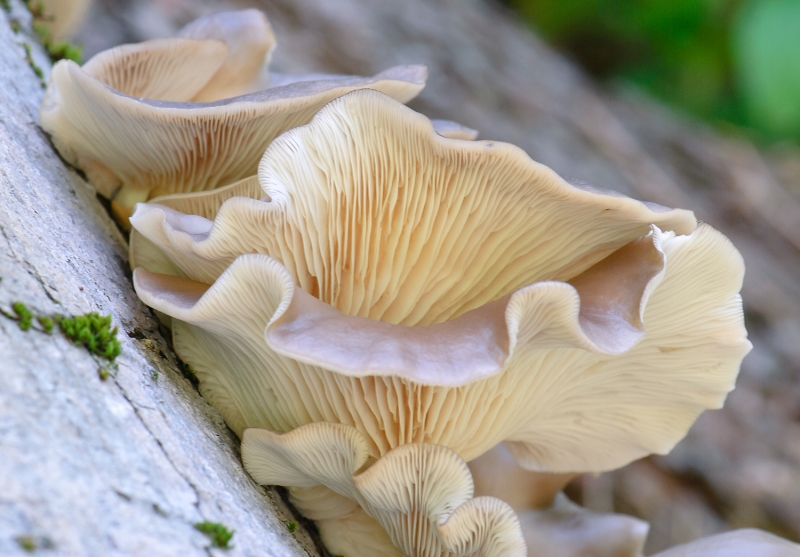
Oyster Mushroom (Pleurotus ostreatus) Photo: Flickr Creative Commons, Marshal Hedin
Northern Oysters
Carnivorous oysters are lurking about in the North Country, and residents who venture into the woods are advised to carry butter and a skillet at all times. Oyster mushrooms, Pleurotus ostreatus, native wood-decaying fungi often found on dead and dying hardwoods, are delectable when sautéed in butter. Maybe hikers should carry a few cloves of garlic and a press as well. It’s good to be prepared.
It may be stretching a point to call oyster mushrooms carnivorous, as the only “meat” they consume are nematodes, which are a type of small roundworm that live in the soil. But they are one of the very few mushrooms in the world known to do this, so why not play it up. The nematodes provide the oysters with nitrogen, a scarce nutrient.
Pleurotus ostreatus is found nearly worldwide, and is commonly gathered for food. Apparently it was first cultivated in Germany during World War I because it will grow on almost anything. Today it is raised by mushroom farmers and hobbyist mycophiles, or in plain English, people who like to grow and eat fungi. In fact, locally grown oyster mushrooms are available in northern NY almost year-round at whole foods stores and Co-ops.
Ranging in color from cream to light brown, oysters have a broad cap shaped like, well, a fan, or maybe an oyster. They are typically between 5 and 25 cm wide, often found on poplar, elm, maple and oak. Their growth habit is odd; they develop sideways off a main stem. They have a mild, nutty flavor, sometimes with a hint of anise or bitter almond, and go well in sauces, soups, and stir-fries. Like most foods that come straight from the Earth, they should be washed before consuming because they may harbor the occasional slug or what-not.
It seems like there is a poisonous look-alike for every tasy fungus out there, which is why I am terrified of mushrooms. Really, it’s the only reason I lock the doors at night. Even distinctive ’shrooms like morels and chanterelles, which would seem impossible to get wrong, have their dangerous doppelgängers. In North America, oysters bear a resemblance to two poisonous species, so if you are fairly new at mushroom hunting, have someone confirm your first few “kills.”
Even if you are not wild about mushrooms, you might consider putting oysters on the menu, because they’re good for you. Many fungi have proven medicinal value, and oysters are no exception. They produce cholesterol-lowering compounds called statins, including one very similar to lovastatin, a drug in wide use today. Research has shown that eating oyster mushrooms seems to result in a significant drop in LDL or “bad” cholersterol. Studies are also underway on a possible link between oyster consumption and an improved immune response, which may prove useful in fighting some cancers.
Oysters are among the easiest mushrooms to cultivate, as they will grow on almost anything, including coffee grounds, disposable diapers, and tissue paper. They are a type of white-rot fungi, a small cadre which is able to break down materials that most fungi cannot touch. But you probably want to be picky about which oysters you eat. For one thing, ones grown on “yuck” do not taste nearly as good as those produced on logs or clean sawdust.
Another issue is that oyster mushrooms have a penchant for certain toxins in the environment, especially metals, and are used commercially in a process called mycoremediation. If present in the soil, mercury is absorbed by the oyster fungus and concentrated in its fruiting bodies, or mushrooms, which are then gathered and disposed of as toxic waste. So maybe you should take a pass on oysters growing on railroad ties and the like.
If carting around condiments and cookware into the woods is too awkward, you can learn to grow your own at home. Cornell Cooperative Extension of St. Lawrence County is offering a half-day workshop on oyster mushroom farming on Saturday, September 30. For more information, call (315) 379-9192 or email ph59@cornell.edu

